This was published 1 year ago
Netanyahu says command centre found at Al Shifa; phone blackout halts aid
By Nidal al-Mughrabi and Ari Rabinovitch
Gaza/Jerusalem: Israeli Prime Minister Benjamin Netanyahu said his army found a command centre two levels below Al Shifa Hospital in the Gaza Strip, along with bombs and weapons.
In an interview on the CBS Evening News on Friday (AEDT), Netanyahu said “terrorist chieftains and terrorists” had fled the hospital grounds as the Israeli military approached.
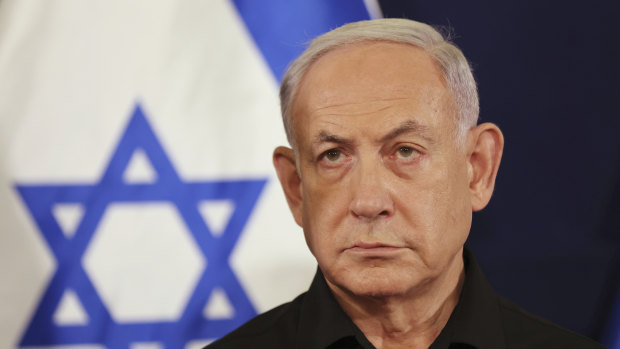
Israeli Prime Minister Benjamin Netanyahu gave his first interview since the hospital raid to CBS.Credit: AP
Answering “of course” to whether he had concrete evidence the hospital was being used by Hamas for war purposes, the prime minister said “on level -2 we found a command and control centre, military communications coded equipment, we found bombs, we found weapons and we also found terror tunnels under the hospital compound”.
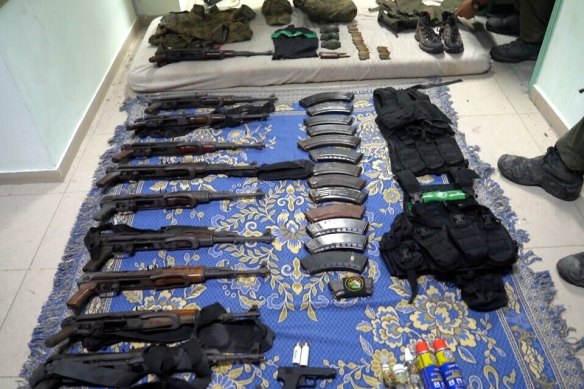
Weapons and other equipment that Israel’s army says it found at Al Shifa Hospital complex in the Gaza Strip.Credit: IDF
“Now we’re doing this very gingerly because we’re, we’re trying to do the moral thing, the right thing,” he said. “To deprive Hamas of having this safe zone in the hospital but at the same time to neutralise its use as a command centre for terrorists.”
Israel has faced some criticism from leaders in the Middle East, the United Nations and elsewhere for the raid, with questions raised over whether it has evidence for its claims of a command centre.
Earlier the Israeli army said soldiers had found a tunnel shaft used by Hamas militants at Shifa. It released a video it said showed a tunnel entrance in an outdoor area of the hospital.
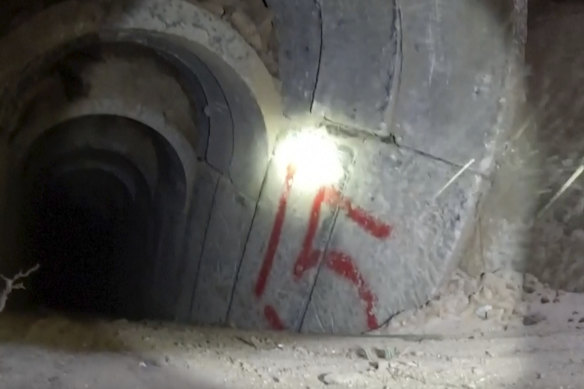
A still from bodycam footage inside a tunnel in an undisclosed location released by the Israeli Defence Forces on November 8.Credit: AP
The video, which Reuters could not immediately verify, showed a deep hole in the ground, littered with and surrounded by concrete and wood, rubble and sand. It appeared the area had been excavated; a bulldozer appeared in the background.
The army said its troops also found a vehicle in the hospital containing numerous weapons.
Military equipment including Kalashnikov rifles and rocket-propelled grenades were also found in the building, it said.

Yehudit Weiss, the Israeli hostage who has been confirmed dead..
It also said the body of Yehudit Weiss, 65, one of about 240 hostages taken by Hamas gunmen when they stormed into southern Israel on October 7 had been recovered from a building near Al Shifa. The body had been identified by forensic examiners and the family had been informed. It did not confirm the cause of death.
Weiss is the third hostage confirmed dead, while four others have been freed and one rescued.
Hamas said in a statement that claims by the US State and Defence departments that the group uses Al Shifa for military purposes “is a repetition of a blatantly false narrative, demonstrated by the weak and ridiculous performances of the occupation army spokesman”.
The US was confident in an assessment from its own intelligence agencies on Hamas activities in Al Shifa hospital and would neither share nor elaborate, White House spokesperson John Kirby said.
Human Rights Watch said hospitals have special protections under international humanitarian law.
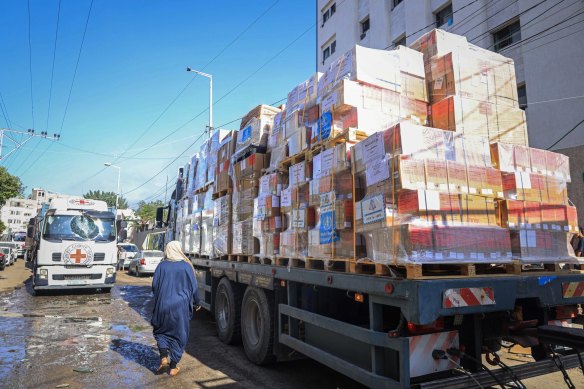
An International Committee of the Red Cross (ICRC) convoy of trucks carrying medical aid arrives at the Al Shifa medical hospital in Gaza City on November 7. Aid agencies say that without fuel they cannot coordinate further deliveries.Credit: Bloomberg
“Hospitals only lose those protections if it can be shown that harmful acts have been carried out from the premises,” the watchdog’s UN Director Louis Charbonneau said.
Meanwhile, internet and telephone services have collapsed across the Gaza Strip for lack of fuel, bringing a potentially long-term blackout of communications at the same time as Israel signalled its offensive against Hamas could next target the south, where most of the population has taken refuge.
The two telecoms companies in Gaza said all energy sources supplying the network had run out and therefore all services in the territory were down. Israel refuses fuel imports, saying Hamas could use them for military purposes.
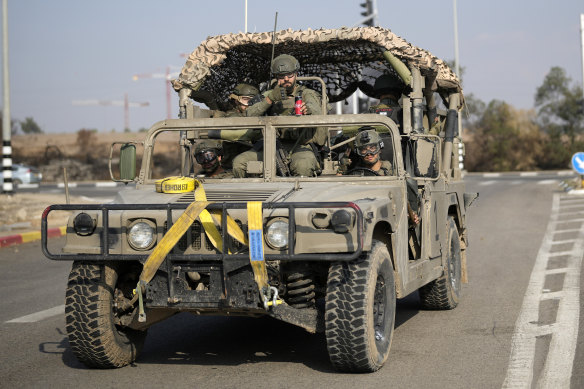
Israeli soldiers make their way to the southern Israeli border with Gaza on November 16.Credit: Getty
With communications out and without fuel, the UN agency for Palestinian refugees, UNRWA, said it was impossible to coordinate humanitarian aid truck convoys.
“If the fuel does not come in, people will start to die because of the lack of fuel. Exactly as from when, I don’t know. But it will be sooner rather than later,” said UNRWA Commissioner-General Philippe Lazzarini.
As of late Thursday night (Friday morning AEDT), there was no further word from the companies, Paltel and Jawwal, whose internet, mobile phone and landline networks remained inoperable.
Palestinian civilians have borne the brunt of Israel’s weeks-long military campaign in retaliation for the October 7 attack by Hamas that Israel says killed 1200 people, mostly civilians.
Gaza health authorities deemed reliable by the United Nations say at least 11,500 people have been confirmed killed in an Israeli bombardment and ground invasion of the Gaza Strip, more than 4700 of them children.
The Israeli military’s chief of staff said Israel was close to destroying Hamas’ military system in northern Gaza and there were signs the army was taking its campaign to other parts of the enclave of 2.3 million people.
Israel distributed pamphlets telling civilians to leave four towns in southern Gaza, areas people had been previously told would be safe.
EU foreign policy chief Josep Borrell, on his first visit to Israel since the attack, called on Israel to do more to protect civilians in Gaza.
“I understand your rage but let me ask you not to be consumed by rage,” Borrell said.
Israeli Foreign Minister Eli Cohen said Hamas was to blame not only for the October 7 attack but also for the current plight of Palestinians in Gaza.
Reuters, Bloomberg, AP
Get a note directly from our foreign correspondents on what’s making headlines around the world. Sign up for our weekly What in the World newsletter.